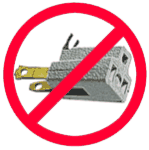Difference between revisions of "Ground Loop"
(Links to related discussions, grounded plug, laptop noises, magenetic pickup noise) |
(== Safety Note ==) |
||
| Line 1: | Line 1: | ||
| + | == Safety Note == | ||
| + | |||
| + | NEVER use a cheater plug | ||
| + | [[Image:Cheaterplug.png]] | ||
| + | |||
| + | or cut the ground plug off an ac power cord. | ||
| + | |||
| + | From the Owners Manual | ||
| + | : Do not defeat the safety purpose of the polarized or grounding-type plug. A polarized plug has two blades with one wider than the other. A grounding-type plug has two blades and a third grounding prong. The wider blade or third prong is provided for your safety. If the provided plug does not fit into your outlet, consult an electrician for replacement of the obsolete outlet. | ||
| + | |||
| + | |||
==Ground Loops== | ==Ground Loops== | ||
This is an excerpt of an article www.rane.com [http://www.rane.com/note110.html Sound System Interconnection] <ref>Excerpt of Article at www.rane.com [http://www.rane.com/note110.html Sound System Interconnection]</ref> | This is an excerpt of an article www.rane.com [http://www.rane.com/note110.html Sound System Interconnection] <ref>Excerpt of Article at www.rane.com [http://www.rane.com/note110.html Sound System Interconnection]</ref> | ||
Revision as of 04:50, 15 May 2007
Safety Note
or cut the ground plug off an ac power cord.
From the Owners Manual
- Do not defeat the safety purpose of the polarized or grounding-type plug. A polarized plug has two blades with one wider than the other. A grounding-type plug has two blades and a third grounding prong. The wider blade or third prong is provided for your safety. If the provided plug does not fit into your outlet, consult an electrician for replacement of the obsolete outlet.
Ground Loops
This is an excerpt of an article www.rane.com Sound System Interconnection [1]
Almost all cases of noise can be traced directly to ground loops, grounding or lack thereof. It is important to understand the mechanism that causes grounding noise in order to effectively eliminate it. Each component of a sound system produces its own ground internally. This ground is usually called the audio signal ground. Connecting devices together with the interconnecting cables can tie the signal grounds of the two units together in one place through the conductors in the cable. Ground loops occur when the grounds of the two units are also tied together in another place: via the third wire in the line cord, by tying the metal chassis together through the rack rails, etc. These situations create a circuit through which current may flow in a closed "loop" from one unit's ground out to a second unit and back to the first. It is not simply the presence of this current that creates the hum -- it is when this current flows through a unit's audio signal ground that creates the hum. In fact, even without a ground loop, a little noise current always flows through every interconnecting cable (i.e., it is impossible to eliminate these currents entirely). The mere presence of this ground loop current is no cause for alarm if your system uses properly implemented and completely balanced interconnects, which are excellent at rejecting ground loop and other noise currents. Balanced interconnect was developed to be immune to these noise currents, which can never be entirely eliminated. What makes a ground loop current annoying is when the audio signal is affected. Unfortunately, many manufacturers of balanced audio equipment design the internal grounding system improperly, thus creating balanced equipment that is not immune to the cabling's noise currents. This is one reason for the bad reputation sometimes given to balanced interconnect.
A second reason for balanced interconnect's bad reputation comes from those who think connecting unbalanced equipment into "superior" balanced equipment should improve things. Sorry. Balanced interconnect is not compatible with unbalanced. The small physical nature and short cable runs of completely unbalanced systems (home audio) also contain these ground loop noise currents. However, the currents in unbalanced systems never get large enough to affect the audio to the point where it is a nuisance. Mixing balanced and unbalanced equipment, however, is an entirely different story, since balanced and unbalanced interconnect are truly not compatible. The rest of this note shows several recommended implementations for all of these interconnection schemes.
Please see the full text: Sound System Interconnection
Related Discussions
- Grounded Plug
- Laptop Playback Noises, Dell Audio FAQ, Dell Ground Loop Problem
- Magnetic Pick-up Noise
- ↑ Excerpt of Article at www.rane.com Sound System Interconnection
